Topic / Climate Implications / Homepage
Climate Implications

Three disruptions driven by just eight technologies can directly eliminate over 90% of net greenhouse gas emissions worldwide within 15 years

Energy
Solar, wind and batteries (SWB) and SWB Superpower will disrupt coal, oil and gas
Transportation
Autonomous electric vehicles (A-EVs) providing Transport-as-a-service (TaaS) will disrupt internal combustion engines and private vehicle ownership
Food & Agriculture
Precision Fermentation and Cellular Agriculture (PFCA) will disrupt meat, milk and other animal products
These technologies are inevitable, decentralized and democratizing
They will allow less-developed areas to leapfrog over previous barriers to human development.
By lifting disadvantaged populations into prosperity, these technologies will level the playing field between rich and poor economies.

How will eight disruptive technologies across three sectors solve the climate crisis?
The disruption of energy, transportation and food & agriculture
Three-quarters of global GHG emissions can be mitigated by eight key technologies that are either already at market and able to be scaled immediately, or are ready to begin being deployed to market.
It will be up to us to decide whether or not we deploy these technologies worldwide rapidly enough to avoid dangerous climate change.
Get Serious: research, deploy & scale
In our Climate Report, we help decision-makers understand the choices they can make by categorizing sources of emissions according to three stages of mitigation readiness: research, deploy, and scale.
Our research provides a guide on how to maximize mitigation efforts efficiently. Without such a framework, decision-makers lack a focused approach to fighting climate change. This runs the risk of misallocating financial, material and political resources.
Witness the transformation
By supporting the clean disruption of energy, transportation, and food & agriculture, societies can choose to reach net zero emissions before 2040. This will lay the groundwork for a complete solution to climate change, simultaneously saving trillions of dollars and improving prosperity and quality of life worldwide.
To do so, we must expand our mindset and rethink what is possible through a larger lens that captures the full complexity of disruption.
Climate Implications
Watch RethinkX Director of Research Adam Dorr explore climate implications in our video series 'Brighter'
Climate In Depth
Explore these topics to learn more about the Climate Implications of coming disruptions

Regions, nations, cities, communities, businesses and investors choosing to embrace and lead the disruptions rather than resist them will reap enormous economic and social rewards as well as environmental benefits.
RethinkX

CLIMATE REPORT
Rethinking Climate Change
Our Rethinking Climate report (published 2021) describes how disruptions already underway in the energy, transportation and food sectors have extraordinary implications for climate change. To maximize the climate benefits of these disruptions, investors, policymakers, civic leaders and other decision-makers should focus attention and resources towards the most impactful opportunities for emissions mitigation.
We can achieve net zero by deploying and scaling the technology we already have. Decarbonizing the global economy will not be costly—it will instead save trillions of dollars.
Regions that embrace and lead the disruptions rather than resist them will reap enormous economic and social rewards, as well as environmental benefits.






-min.png?width=732&name=Copy%20of%20RethinkX%20-%20In%20the%20News%20(4)-min.png)






-min-2.png?width=732&name=Copy%20of%20Website%20imagery%20-%20Featured%20Image%201200x628%20(1)-min-2.png)




